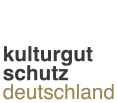Loans from abroad to Germany
A range of different instruments have been put in place for the purpose of simplifying cross-border loans of cultural objects to Germany. The legally binding commitments to return cultural property enshrined in Section 73 of the German Act on the Protection of Cultural Property (Kulturgutschutzgesetz, KGSG) are among the most important of these instruments.
Legally binding commitments to return cultural property
Legally binding commitments to return cultural property – without which cross-border loans would be almost inconceivable – are a legal instrument that had already proven its worth before the entry into force of the Act on the Protection of Cultural Property.
The term “legally binding commitment to return cultural property” refers to the practice whereby a country provides a foreign lender with the assurance that his or her cultural object, loaned in connection with an international exhibition project, will be returned after the exhibition has ended. Commitments of this kind offer comprehensive protection against any risk that proceedings might be initiated against the loaned cultural object during its stay in Germany as a result of an action brought before a court or enforcement measures.
The cultural object may be loaned in connection with an exhibition or any other form of public display in and by institutions responsible for preserving cultural property, including any restoration work required beforehand. Academic research into cultural objects is also explicitly recognized as a valid reason for a legally binding commitment to return cultural property.
The Act on the Protection of Cultural Property specifies a maximum period of validity of up to two years for a legally binding commitment to return cultural property. In justified exceptional cases, the period of validity may be extended up to a maximum of four years. If it is envisaged that the cultural object will be exhibited at several locations in Germany, a legally binding commitment to return cultural property covering all of the locations can be issued by the competent Land authority with jurisdiction for the first location.
Legally binding commitments to return cultural property do not merely rule out any risk that proceedings might be initiated against the cultural object in question during its stay in Germany as a result of an action brought before a court or enforcement measures; they also prevent entry of the cultural object into a directory of nationally valuable cultural property during its stay in Germany. This arrangement is furthermore intended to simplify cross-border loans, since it dispels the concerns raised by foreign lenders that their cultural objects might fall under the scope of provisions aimed at preventing the exodus abroad of German cultural property. Yet the legislator’s aim in introducing this instrument was to promote international exchanges of culture, which means that such commitments can be issued only to lenders based abroad, inter alia in view of the legislative history and the associated restrictions placed on third-party rights (see the explanatory memorandum for Section 74 KGSG: “In line with international practice, the borrower must forward the legally binding commitment to return cultural property to its contractual partner (the lender abroad) prior to or upon the arrival of the cultural object in Germany. Direct contact between the lender abroad and the relevant Land authority with jurisdiction for the protection of cultural property is neither required nor envisaged.” – see Bundestag printed paper no. 18/7456, page 113). Pursuant to Section 74 (1) sentence 1 KGSG, an application for a legally binding commitment to return cultural property must be submitted by the borrower in Germany to the competent authority, which in turn will issue the legally binding commitment to return cultural property to the lender based abroad. No commitments of this kind can therefore be issued to lenders with a (residential) address in Germany.
A downloadable leaflet on legally binding commitments to return cultural property summarizes the information.
Assurance pursuant to Section 10 (7) KGSG that entry proceedings will not be initiated
Legally binding commitments to return cultural property are the most appropriate legal instrument for protecting loans whose stay in Germany will be limited to a predictable period of time. The latter point is important with a view to ensuring that potential third-party rights are not restricted to a disproportionate degree, since commitments of this kind prevent any third parties that might assert rights to the cultural objects from seeking recourse before the German courts or with the German law enforcement authorities.
Section 10 (7) KGSG allows the competent supreme Land authority to assure the lender on a binding basis that no procedure for entry in a directory of nationally valuable cultural property will be initiated; this is aimed at dispelling any concerns on the part of foreign lenders regarding the provisions of German law intended to prevent the exodus of cultural property, even in the case of long-term loans, or in other words cross-border long-term loans for which a legally binding commitment to return cultural property cannot be issued or – as a result of the time limits imposed on this instrument – cannot be issued for the entire period of the loan. The upshot of any such assurance is that proceedings for the entry of the relevant cultural object into a directory of nationally valuable cultural property cannot be initiated until six months after the expiry of the loan agreement.
A detailed description of the significance of the statutory provisions can be found in the section on Collectors.


